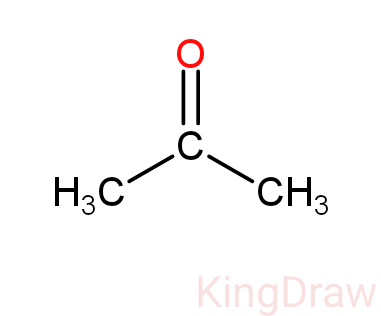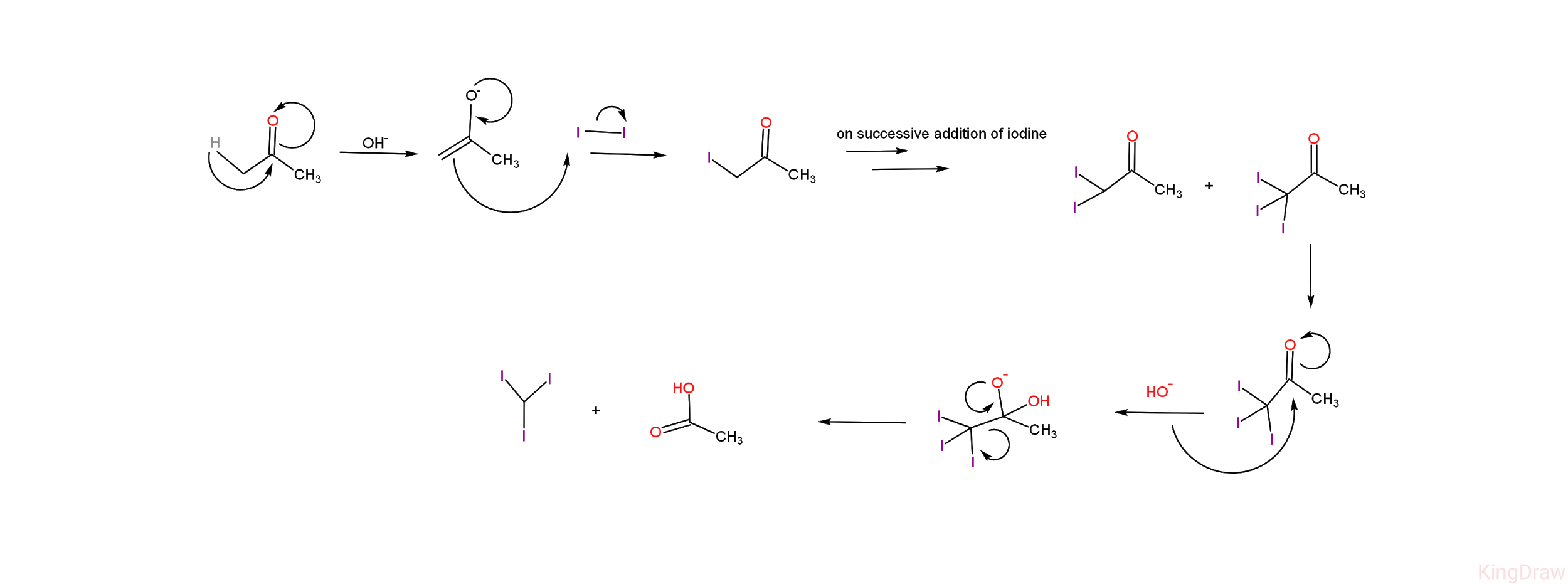Answer
35.4k+ views
Hint: Iodoform reaction of acetone will lead to the products - acetic acid (${ CH }_{ 3 }{ CO }{ O }{ H }$) (sodium acetate) and iodoform (${ CH }I_{ 3 }$). On writing the mechanism of the reaction, we can find certain stable intermediates are also formed. None of these intermediates contains a C=C bond. So, among the options given, the compound with C=C is the answer.
Complete Step by Step Solution:
-Structure of acetone is given below:

-Iodoform reaction is used to identify the presence of carbonyl compounds in compounds.
-Here in the iodoform reaction of acetone, the acetone will be reacted by ${ I }_{ 2 }$ in the presence of NaOH to form acetic acid (sodium acetate) and iodoform.
-When we look at the mechanism of this reaction, we can see many intermediates formed in between.
-Given below is the diagrammatic representation of the mechanism of iodoform reaction of acetone. -From the mechanism, we can see that the iodoform reaction of acetone leads to the products - iodoform (${ CH }I_{ 3 }$) and acetic acid (${ CH }_{ 3 }{ CO }{ O }{ H }$ ).
-From the mechanism, we can see that the iodoform reaction of acetone leads to the products - iodoform (${ CH }I_{ 3 }$) and acetic acid (${ CH }_{ 3 }{ CO }{ O }{ H }$ ).
-Apart from the final products, there are certain stable intermediates formed in the reaction - i.e, on addition of iodine on acetate ion, it leads to the formation of 1-iodoacetic acid (${ CH }_{ 3 }{ CO }{ CH }_{ 2 }{ I }$) and on successive addition of iodine , two more compounds are formed which are 1,1-di iodoacetic acid (${ CH }_{ 3 }{ CO }{ CH }{ { I }_{ 2 } }$ ) and 1,1,1- tri iodoacetic acid (${ CH }_{ 3 }{ CO }{ C }{ { I }_{ 3 } }$)
-So, these compounds ${ CH }_{ 3 }{ CO }{ CH }_{ 2 }{ I }$,${ CH }_{ 3 }{ CO }{ CH }{ { I }_{ 2 } }$ , ${ CH }_{ 3 }{ CO }{ C }{ { I }_{ 3 } }$are formed in the iodoform reaction of acetone, which are satisfied by Option (A), option (C) and option (D).
-In the question, it has been asked which among the options are not formed in the iodoform reaction of acetone and that compound is Option (B)${ ICH }_{ 2 }{ CO }{ C }{ H }_{ 2 }$.
Therefore, the correct answer here is Option (B)${ ICH }_{ 2 }{ CO }{ C }{ H }_{ 2 }$.
Note: Iodoform reaction occurs when there is an $\alpha $- hydrogen in that compound, and this $\alpha $ - hydrogen will be substituted with iodine leading to the formation of iodoform. In the case of acetone, there are three $\alpha $ - hydrogens present in the compound, so all the three $\alpha $ - hydrogens are replaced by iodine successively and thereby these stable intermediates are formed.
Complete Step by Step Solution:
-Structure of acetone is given below:

-Iodoform reaction is used to identify the presence of carbonyl compounds in compounds.
-Here in the iodoform reaction of acetone, the acetone will be reacted by ${ I }_{ 2 }$ in the presence of NaOH to form acetic acid (sodium acetate) and iodoform.
-When we look at the mechanism of this reaction, we can see many intermediates formed in between.
-Given below is the diagrammatic representation of the mechanism of iodoform reaction of acetone.
 -From the mechanism, we can see that the iodoform reaction of acetone leads to the products - iodoform (${ CH }I_{ 3 }$) and acetic acid (${ CH }_{ 3 }{ CO }{ O }{ H }$ ).
-From the mechanism, we can see that the iodoform reaction of acetone leads to the products - iodoform (${ CH }I_{ 3 }$) and acetic acid (${ CH }_{ 3 }{ CO }{ O }{ H }$ ).-Apart from the final products, there are certain stable intermediates formed in the reaction - i.e, on addition of iodine on acetate ion, it leads to the formation of 1-iodoacetic acid (${ CH }_{ 3 }{ CO }{ CH }_{ 2 }{ I }$) and on successive addition of iodine , two more compounds are formed which are 1,1-di iodoacetic acid (${ CH }_{ 3 }{ CO }{ CH }{ { I }_{ 2 } }$ ) and 1,1,1- tri iodoacetic acid (${ CH }_{ 3 }{ CO }{ C }{ { I }_{ 3 } }$)
-So, these compounds ${ CH }_{ 3 }{ CO }{ CH }_{ 2 }{ I }$,${ CH }_{ 3 }{ CO }{ CH }{ { I }_{ 2 } }$ , ${ CH }_{ 3 }{ CO }{ C }{ { I }_{ 3 } }$are formed in the iodoform reaction of acetone, which are satisfied by Option (A), option (C) and option (D).
-In the question, it has been asked which among the options are not formed in the iodoform reaction of acetone and that compound is Option (B)${ ICH }_{ 2 }{ CO }{ C }{ H }_{ 2 }$.
Therefore, the correct answer here is Option (B)${ ICH }_{ 2 }{ CO }{ C }{ H }_{ 2 }$.
Note: Iodoform reaction occurs when there is an $\alpha $- hydrogen in that compound, and this $\alpha $ - hydrogen will be substituted with iodine leading to the formation of iodoform. In the case of acetone, there are three $\alpha $ - hydrogens present in the compound, so all the three $\alpha $ - hydrogens are replaced by iodine successively and thereby these stable intermediates are formed.
Recently Updated Pages
If a wire of resistance R is stretched to double of class 12 physics JEE_Main

The path difference between two waves for constructive class 11 physics JEE_MAIN

What is the difference between solvation and hydra class 11 chemistry JEE_Main

IfFxdfrac1x2intlimits4xleft 4t22Ft rightdt then F4-class-12-maths-JEE_Main

Three point particles of mass 1 kg 15 kg and 25 kg class 11 physics JEE_Main

Which of the following explanation is best for not class 12 chemistry JEE_Main

Other Pages
Two identical charged spheres suspended from a common class 12 physics JEE_Main

Oxidation state of S in H2S2O8 is A 6 B 7 C +8 D 0 class 12 chemistry JEE_Main

Explain the construction and working of a GeigerMuller class 12 physics JEE_Main

The mole fraction of the solute in a 1 molal aqueous class 11 chemistry JEE_Main

If a wire of resistance R is stretched to double of class 12 physics JEE_Main

Differentiate between homogeneous and heterogeneous class 12 chemistry JEE_Main



